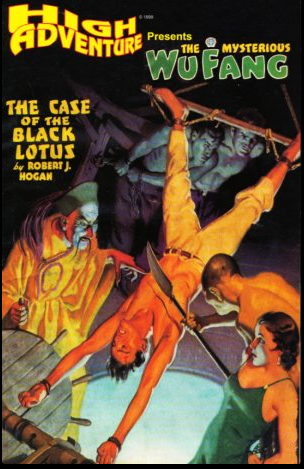Magazine Review: High Adventure #47: The Case of the Black Lotus edited by John P. Gunnison
The success of Sax Rohmer’s classic villain Fu Manchu led to other writers trying to create their own Yellow Peril master villains. A couple of them even got their own short-lived pulp magazines. This magazine reprints the stories from The Mysterious Wu Fang February 1936, the sixth issue of seven in that series. Unlike the high-minded Fu Manchu, who was interested in freeing China (and East Asia in general) from foreign control, and later in creating world peace, Wu Fang was much more interested in controlling crime and killing people for the sake of killing.

Up against the crimelord and his army of twisted henchmen and exotic creatures were federal agent Val Kildare and two-fisted reporter Jerry Hazard. Jerry was in love with Wu Fang’s lovely captive Mohra, and the affection is returned, but they are kept apart by her cruel captor, who became increasingly angry at her disobedience.
In “The Case of the Black Lotus” by Robert J. Hogan, Jerry is given an advance copy of an article about Chinese secret societies, including the Chang Li, best known for a) a ritual burning of an effigy of a long ago emperor ala Guy Fawkes Day, and b) the cultivation of the black lotus, the secret of which is exclusive to the society. While eating dinner in Chinatown, Jerry learns that there’s to be a sacrifice of a white woman tonight. When he goes to an address that might have something to do with this evil plan, he finds the corpse of the article writer, adorned with a black lotus blossom.
Jerry contacts Val Kildare and their mutual friend Rod Carson, an archaeologist. They learn from newsboy Cappy that there’s to be a parade at midnight by the Chang Li society. Carried in the parade is a Chinese coffin, and when our heroes disrupt the parade, the coffin does not contain a flammable effigy, but Mohra! This is clearly a shock to the marchers.
Jerry is sent off with his sweetie to get her medical attention, and Val convinces the police to let the parade continue so that he can discover the secret society’s meeting place. At that meeting place, Val and Rod find Wu Fang among the celebrants at the ceremony, but Wu Fang is shouting angrily and then escapes almost instantly.
Then a series of bizarre murders begins, each marked with the blossom of the black lotus!
We never get the entire backstory on Wu Fang’s motives here, but in addition to running his own criminal organization, he was also a member of the Chang Li. He’d been put in charge of providing the effigy for the society’s annual burning ceremony, but substituted Mohra instead, violating their rules. Whatever else the Chang Li were up to, human sacrifice was off the table. Our heroes arrived just as he was being expelled for this offense.
Wu Fang claims that being expelled caused him to seek revenge by framing the Chang Li for the black lotus murders, but this doesn’t hold up as the first one happened well before the parade, and the others are too well planned to be a thing he wasn’t going to do before.
Chang Li leader Wong Chu is more than willing to help our heroes against Wu Fang, but first must be rescued from the police, who have completely bought that Wu Fang is working on behalf of the secret society.
It’s an exciting story with some cool scenes, such as a blacked-out newsroom that’s had a basket full of venomous critters released in it, and a creepy voyage to a black tomb in the abandoned cemetery.
But as you might expect from a Yellow Peril story, there’s an undercurrent of racism that can’t be ignored. East Asians are referred to in the narration and by the characters using outdated and derogatory terms, and even the “good” Chinese characters are mysterious and inscrutable. Also, there’s torture, both by the villains, and by the police.
None of our main trio understands a lick of Chinese language, leaving them at the mercy of whoever deigns to speak English to explain important plot details.
I do like the cameo by adorably evil little girl Nee-Sa, who apparently is just hanging around the graveyard to give people jump scares.
According to the editorial note by Mr. Gunnison, by this point the magazine was cutting costs by using a less expensive artist, and trimming the page count. Thus there’s only one backup story.
“The House of Doom” by Arden X. Pangborn features police detective Lee Tait, who does speak a little Cantonese and Mandarin. He’s assigned to find out what happened to a couple of police officers who disappeared in Chinatown. Lee, as it happens, is an amateur painter with decent training but not much talent, so he goes undercover as an artist painting street scenes.
This cover quickly gets Lee ignored, so he’s able to observe what’s going on around him. When a federal agent is murdered right in front of him, Lee is able to combine his observations with the Chinese number that is the dying man’s last word to figure out which business is a front for sex trafficking. But knowing isn’t enough, he needs solid evidence–and that means putting his own life at risk!
It’s an okay story, but still has some racism.
This issue will be of most interest to pulp fans who enjoy Yellow Peril stories. You might want to read the other Wu Fang stories first, as they do have some continuity.

